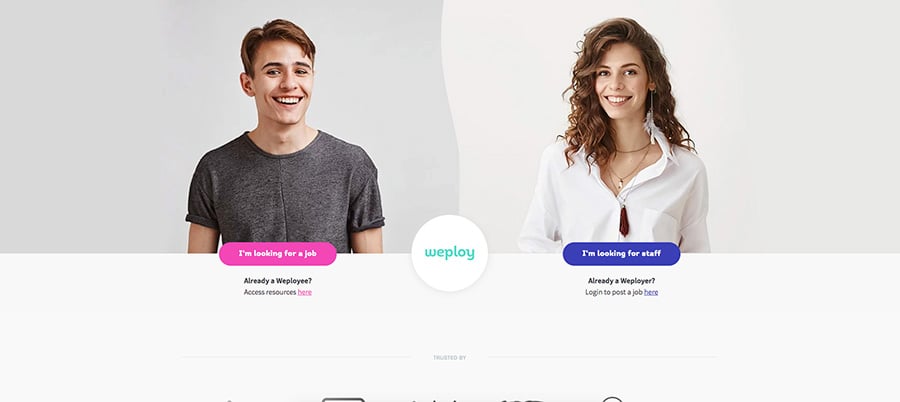“95% of buyers chose a solutions provider that provided them with ample content to help them through each stage of the buying process.” (Demand Gen Report)
Now before you tune out and think that content is the marketing team’s responsibility, think about how this is affecting you in your sales capabilities. What might you like to ask your siblings in Marketing for to help you close the deal? We’re sure we can help you align your pitch more personally to your lead through the support of the right content.
It’s story time
Most of you have met a version of Gill from The Simpsons, the perennial battler sales rep who tries hard but always falls short. He just can't get out of his own way! We can empathise with his struggles and challenges because, we have all been there at some stage.

Image credit: Simpsons Wikia
Now, say Gill just had an awesome first meeting with a prospect and they are super excited about working together. They have a strong business need but firstly they need to better understand how your widget could be used in their environment. Gill gets back to the office, pulls out his trusty 1 page brochure, with detailed technical product specifications and sends it across - then sat back and waited for the phone to ring. But all he got was radio silence.
Although they promised that they would get back to Gill with commentary, now they aren't even answering calls. A couple of weeks later Gill finally speaks to them. They loved the pitch but when they passed the specifications document to their IT team and they reported back that they had another tool that could do something similar and that IT would shoulder the work. So what happened?
The wrong content can send you into sales orbit
When a space shuttle returns to earth there is a real possibility that it will hit the earth's atmosphere and skip back into orbit. It needs to hit the earth's atmosphere at the exact trajectory, taking into account the size, weight and speed of the cargo to ensure that they don't head back into space. This is exactly what happened to Gill.
The prospect was early in their buying process but eager to learn more, Gill had positioned himself well as a trusted advisor. Then he sent the first, probably only, piece of content available to him, a product specifications document, which cost him the deal. So why did that happen? Just like the misaligned spaceship rebouncing back to space, there are many things that need to be taken into account for content to support the sales process.
82% of buyers viewed at least 5 pieces of content from the winning vendor. (Forrester)
Gill's prospect wasn't interested in the product specifications. They were still very early in the buying process, so were looking for more guidance as to how their problem could be solved. Even worse, it undermined his hard earned role as a trusted advisor, demonstrating that he didn't care enough about them to understand and address their specific need and was just after the quick sale. Worse still, it was a hindrance as the technical nature of the document invited IT into the deal before Gill could uncover the real business pain.
Match your content to the Buyer’s Journey
The key to avoiding ol' Gill's predicament is to ensure you are sending the content that aligns to the prospects stage in the buying process, then ensure you take into account other variables from their situation - their business pain, the role they play in the business and buying decision, the size of the opportunity and more. That sounds like a lot of work - is it worth it?
Nurtured leads make 47% larger purchases than non-nurtured leads. (The Annuitas Group)
Just like we described in our previous post "CRM, you're doing it wrong" the typical buyer embarks on a familiar journey when they are making a purchase decision which you can match with the right content at the right time and nurture through them through the sales process
Below is a quick guide to the type of content that you can leverage at each stage of the process...
A Guide To Content Types
Status Quo
This is your opportunity to engage and earn the trust of your customer by introducing them to your expertise and build trust with independent research. Examples of content:
- Industry whitepapers
- Informative surveys
- Educational eBooks
If you don’t have your own don’t be afraid to share great content you find.
Attract
The buyer is looking for a consultant that has their best interest at heart and guides them down the path of success. Examples of content:
- Webinars
- eBooks
- Infographics
Remember, ease up on the sale speak.
75% of buyers want marketers to curb the sales-speak in their content. (DemandGen Report)
Convert
Here is your opportunity to demonstrate the value that you have had with companies facing similar challenges, giving the prospect some social proof then providing confidence that you are the partner vested in their success. Examples of content:
- Case studies
- Customer references
- Third party stories
- Implementation guide
Close
Purchase decisions are now happening by consensus, there may be people in the decision making process that you will never meet! You have to be prepared to educate these individuals while supporting your main point of contact and empowering them to pitch on your behalf.
- Proposal document, including
- Summary of challenges
- Business pain
- Social proof
- ROI
- Plan out the next steps with an implementation guide
Delight
You may think that your job is done, the customer is happiest just when they sign on the dotted line. Use that euphoria to ask them to send through some of your content from the start of the process to their industry colleagues facing similar challenges. Ask them which piece of content will resonate the most.
Plant the seeds for upsell and cross-sell. Once they are experiencing success and you have earned their trust you can introduce new concepts
Where to now?
Once you have created the content to match the buyer’s journey now you need to test and see which content is performing better at each stage. Fortunately there are tools like Sidekick, Attach.io, Clearslide and many more that can help you measure who is reading your content, what page they spend the most time on, who else in the organisation they have forwarded it to and how many times they have opened it. These events are also great triggers you can use to re-engage with your prospects to accelerate the sales process.
Harness the power of arming your sales team with the right content to match the different stages of the buyer’s journey and help avoid ol’ Gill’s mistakes in your business.
Happy Selling!
Credit: Statistics in this post taken from Hubspot



